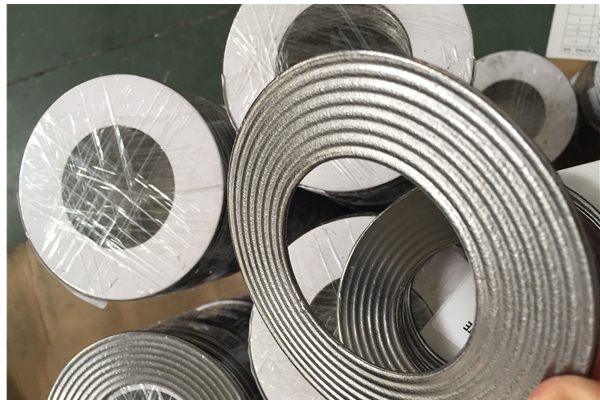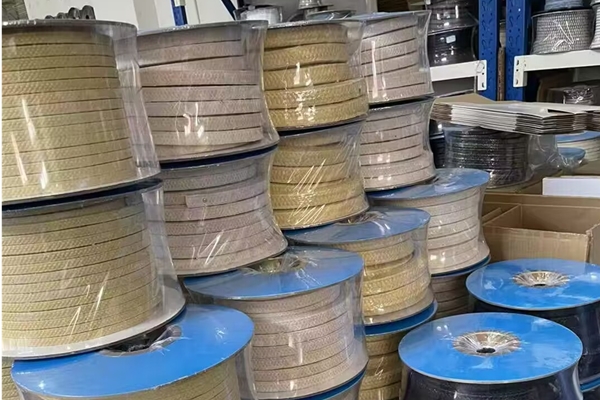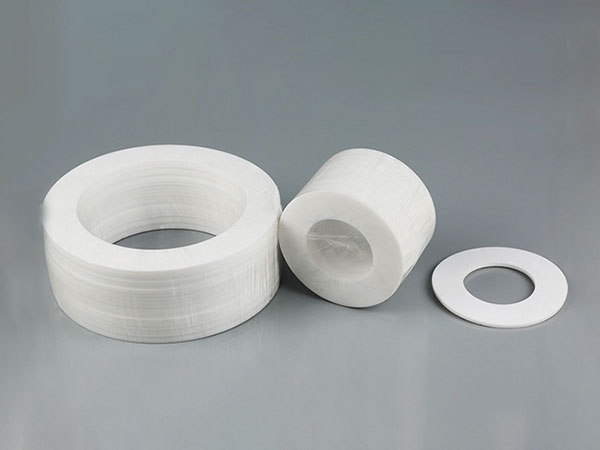1. Material Selection
1). Metal corrugated gaskets
Characteristics: Made from metals like stainless steel, these gaskets exhibit high strength, heat resistance, and corrosion resistance, making them suitable for high-pressure and high-temperature environments.
Applications: Commonly used in industries with stringent sealing requirements, such as petrochemical, power generation, and aerospace.
Advantages: The corrugated metal inner ring enhances resilience, reducing the sealing surface area and making it ideal for sealing under low bolt loads. This design ensures reliable performance even with minimal clamping force.
2). Rubber corrugated gaskets
Characteristics: These gaskets offer excellent elasticity and sealing performance but have relatively lower heat and corrosion resistance.
Applications: Ideal for ambient temperature and low-pressure environments, such as automotive, household appliances, and general machinery.
Advantages: Low cost and easy installation make them suitable for applications requiring frequent replacement, such as in consumer products or light industrial use.
3. Plastic or Composite corrugated gaskets
Characteristics: Lightweight and highly corrosion-resistant, but with limited strength and heat resistance.
Applications: Found in industries requiring high material purity, such as food processing, pharmaceuticals, and certain chemical applications.
Advantages: Customizable to meet specific chemical environment needs, offering versatility for niche applications where metal or rubber might degrade.
2. Size and Thickness
Size Matching
Select the gasket size to match the equipment interface dimensions, ensuring complete coverage of the sealing surface to prevent leaks or failure due to size mismatches.
For irregular interfaces, consider custom designs to achieve a perfect fit, which is critical in maintaining sealing integrity.
Thickness Selection
Thickness directly affects the gasket’s compressibility and resilience. Thicker gaskets are better suited for scenarios requiring significant cushioning or filling larger gaps, though they may increase installation difficulty.
Thinner gaskets are preferable for precision equipment or applications with strict space constraints, as they provide a tighter fit but less flexibility.
3. Environmental Considerations
Temperature
In high-temperature environments (e.g., boilers, engines), choose heat-resistant materials like stainless steel or special alloys to withstand thermal stress without degrading.
In low-temperature environments (e.g., refrigeration units), opt for cold-resistant rubber or composite materials to maintain flexibility and sealing performance.
Pressure
High-pressure environments (e.g., hydraulic systems) require high-strength metal Corrugated gaskets are sealing components designed to create a tight seal between two surfaces, typically in pipes, flanges, or machinery. The wave-like structure improves flexibility and resilience while combining metal and soft materials addresses diverse industrial needs to prevent deformation under extreme loads.
Low-pressure environments can use rubber or plastic gaskets, reducing costs while still providing adequate sealing.
Chemical Corrosion
In environments with strong acids, alkalis, or corrosive gases, select corrosion-resistant materials like PTFE (polytetrafluoroethylene)layer gaskets or special alloys to ensure long-term durability.
Vibration and Impact
For equipment with significant vibration, choose gaskets with high elasticity and fatigue resistance, such as rubber or composite materials, to absorb shocks and maintain sealing performance over time.
4. Installation and Maintenance
Proper Installation
Ensure the gasket and sealing surface are clean and free of debris to prevent sealing failure caused by contaminants.
Apply load evenly to avoid excessive pressure in specific areas, which could deform or damage the gasket. Uneven pressure can lead to leaks or premature failure.
Regular Inspections
Periodically check the gasket’s condition for signs of wear, aging, or deformation, and replace it promptly if necessary.
In high-temperature, high-pressure, or corrosive environments, shorten the inspection intervals to catch potential issues early and maintain system reliability.
Replacement Considerations
When replacing a gasket, select a replacement with the same specifications and material as the original to ensure compatibility and performance.
For harsh environments, consider upgrading to more durable materials or advanced designs to extend the gasket’s lifespan and improve sealing efficiency.
5. Unique Advantages of Metal Corrugated Gaskets
Enhanced Resilience
The corrugated metal inner ring design significantly boosts the gasket’s spring-back ability, allowing it to maintain effective sealing even under low bolt loads. This is particularly useful in applications where high clamping forces are impractical.
Reduced Sealing Surface Area
By minimizing the sealing contact area, metal corrugated gaskets are sealing components designed to create a tight seal between two surfaces, typically in pipes, flanges, or machinery. The wave-like structure improves flexibility and resilience, while the combination of metal and soft materials addresses diverse industrial needs, and reduces the need for high bolt preload, improving sealing reliability while simplifying installation and maintenance.
Superior to Metal Jacketed Gaskets
Compared to traditional metal jacketed gaskets, metal corrugated gaskets are sealing components designed to create a tight seal between two surfaces, typically in pipes, flanges, or machinery. The corrugated structure improves flexibility and resilience, while the combination of metal and soft materials addresses diverse industrial needs and offer better performance and cost-effectiveness, especially in scenarios requiring high sealing performance and long service life. They provide a modern alternative with enhanced durability and adaptability.
In common, choosing the right corrugated gasket requires a comprehensive evaluation of factors such as material, size, thickness, and application environment. Corrugated Gaskets stand out due to their high resilience and excellent sealing performance, making them particularly effective in high-pressure, high-temperature, and low-bolt load scenarios. In practice, proper installation and regular maintenance are crucial to ensuring gasket performance. By applying scientific selection criteria and following best practices, you can significantly enhance equipment sealing performance and operational reliability, ensuring safety and efficiency in industrial applications.




